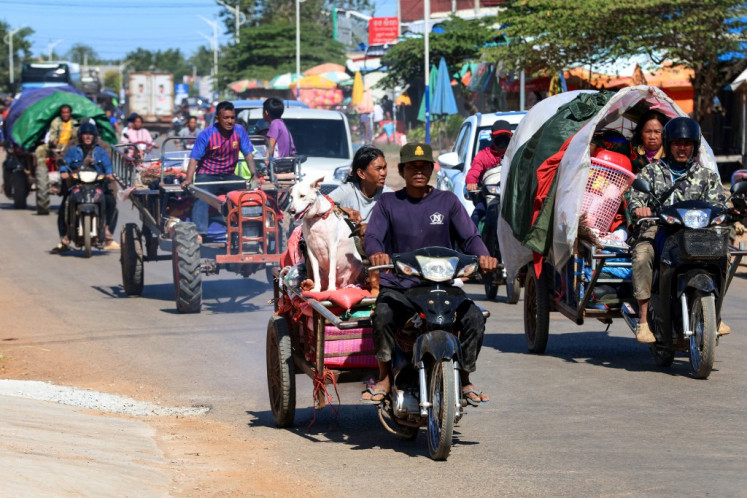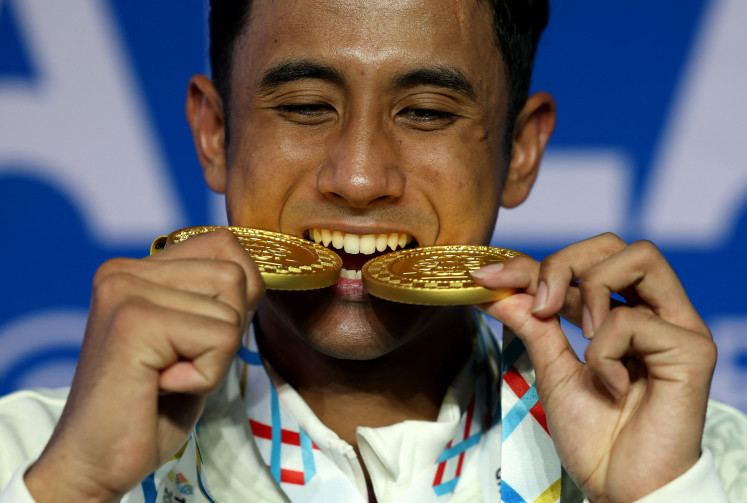Popular Reads
Top Results
Can't find what you're looking for?
View all search resultsPopular Reads
Top Results
Can't find what you're looking for?
View all search resultsMyanmar: Tale of two cities
Shwedagon pagodaOther than the massive 15-lane thoroughfare that could double as an airstrip, another spectacular attraction in Nay Pyi Taw, the new capital of Myanmar, is the country’s parliamentary building
Change text size
Gift Premium Articles
to Anyone
Shwedagon pagoda
Other than the massive 15-lane thoroughfare that could double as an airstrip, another spectacular attraction in Nay Pyi Taw, the new capital of Myanmar, is the country’s parliamentary building.
It is a massive imperial compound that can only be gawked from a distance. Far enough to obscure what really happens inside — but then again, the long distance may be intentional, because not a lot happens inside the building. The country’s lower house only has five sessions per year and we can safely assume that lawmakers, and majority of government workers, don’t want to be in Nay Pyi Taw in the first place.
Nay Pyi Taw is the place where no one wants to be. As one travel writer succinctly puts it, this is the place where “no one bothered settling over the past 2,000 years”. Had it not been for a sudden decision by the country’s military junta, only farmers and cattle herds would live in this arid, mountain-framed spot in Central Myanmar, 400 kilometers south of the old capital, Yangon.
Stairway to Shwedagon pagoda in Yangon.Had it not been for the construction boom ahead of the SEA Games 2013 and the influx of foreigners and investors, who are now jockeying for getting the first contracts from the local government, Nay Pyi Taw could easily win the title as the dullest capital city in the world.
Welcome to the world’s capital of boring! This is the place where most of government buildings are painted grey as if to match the overhanging cloud that graces its September afternoon sky.
Even when arriving early on a Monday, travelers who step out of the first of only four flights to the city, walk to a modern but deserted, concrete-and-glass airport, which features no duty-free shops or even a refreshment stand. Security check was casual and baggage claim was completed in minutes. In fact, we are probably the first passengers to arrive in the airport on the start of the week! And the 45-minute travel from the terminal to downtown Nay Pyi Taw was a trip back in time.
In fact, we are probably the first passengers to arrive in the airport on the start of the week! And the 45-minute travel from the terminal to downtown Nay Pyi Taw was a trip back in time.
Along a six-lane tree-lined highway, there’s nothing to see but a long stretch of paddy fields with water buffaloes grazing on them and by the time we arrived in the city, we did not even know where the city limit was. This is probably what much of Southeast Asia looked like in the late 1950s or 1960s.
We know that we are in Nay Pyi Taw was when we begin to see signs of hotel, government buildings and a handful of shopping malls. Then there’s the inexplicably large presence of Thai restaurants. With so many Japanese, Chinese, American businessmen and UN workers coming into the city following the lifting of the sanction by the Western government, these Thai establishments appear to be the only place where the foreigners could gather and socialize after a long hot stay in a place where nothing ever happens.
Streets of YangonEven on the busiest working day, the biggest traffic that this capital city has is the convoy of military truck followed by a handful of locals speeding on their Chinese-made motorbikes.
And in a city with so little attractions, other than the massive knock-off Shwedagon, the most visited site is the parliament, although it does not function as a tourist attraction.
The compound was surrounded by 5-meter-tall fence that would bar visitors from entering the premise, but close enough for them to snap photos from a distance. Military personnel stationed to guard the compound lazily plopped down their M16 on their lap when we passed them by and gave us a confused look when we drove off in our rented taxi.
“Don’t get too close,” shouted our taxi driver when we stood to close to the fence, snapping pictures. Why work hard to maintain security when they can deputize the job to the general population?
So much for a police state!
The job of maintaining security, which could also mean confusing foreigners, is also deputized to road signs, which are all written in local script. And if we believe that the regime moved to this capital because they fear Iraq-like invasion, the road sign appears to confuse all the ground troops parachuted to the city.
The fence that circles the parliament building is in fact symbolism for the top-down political liberalization in the country. There have been talks that the current regime, learning from the breakdown of sociopolitical order in transitional Indonesia, hold on to the reins of democratization tightly and decide how fast it ought to go.
The gate to the parliament building in Nay Pyi Taw.
The fenced parliament building is another way of the Myanmar junta of telling its people that the regime will set the terms and conditions for transition to democracy.
In the old capital Yangon, such liberalization means that the face of Nobel laureate Aung San Suu Kyi could be plastered on T-shirts to be sold to tourists and the logo of her political party, the National League for Democracy, can now appear on coffee mugs.
The liberalization in Myanmar could also mean that the first sign that foreigners see when they enter Yangon is the oversized banners for Coca-Cola and Samsung attached to the wall of the city’s international airport.
Inside Yangon, these Coca-Cola and Samsung billboards have to vie for space with ones promoting thanakha (traditional makeup for women) with pictures of plus-size Myanmar beauties smiling proudly with their faces smothered in soft-colors.
The juxtaposition of old and new, West and traditional, is now what gives new color to Yangon.
Traveling next to each other, in the narrow streets of Yangon, are the latest edition of Japanese SUVs and rickety old trucks and taxis that Asia left behind in the late 1960s.
While the affluent and the powerful get cellular services and free WiFi at the lobby of some of the city’s plush hotels, tourist spots and at the ground of the world-renown Shwedagon pagoda (the real one this time), longyi-wearing, betel-chewing Yangon locals can easily be spotted using landline connections from makeshift payphones at almost all bus stops throughout the city.
Skyscrapers in Yangon
Behind some of the city’s modest shopping malls are traditional markets bustling with buyers and vendors haggling over a slice of watermelon, 1 kilogram of rice or the traditional betel mix. Anti-smoking campaigns will probably be of little use in this city, as none of males in the city seem to smoke.
The relative absence of smoke — be it from car exhaust, factories or smokers — gives Yangon the feel of an imperial town from the time when kings and regents still ruled their subjects. If you can ignore the new Japanese SUVs and ubiquitous roadside Samsung ads, you can easily think that this is still the same city that George Orwell came to in 1924, before he embarked on a journey to shoot that famous elephant.
Of course there are the people, men in longyi and petite demure women in traditional Burmese dress, who exude a quiet confidence. Their demeanor supports the impression of their ability to endure decades of isolation.
It takes a great deal of patience — and almost one hour — just to get a ride on a packed public transportation truck. Drivers wait patiently for the traffic to pass, on some of city’s congested narrow roads —and they only honk when they are trying to overtake other motorists.
This patience has enabled life in Yangon to move at a slow, glacial pace. After all, what should you do when generals call all the shots — there are even instructions to go vegan on national television!
And probably 20 years from now when capitalism is already in full swing, when high-rises dominates Yangon skyline, when women are already dressed in Zara and most of the men suited-up en route to some glass and steel office, when congestion is worse, people of Yangon will rue the day when life drifted by slowly like the clouds that roll by in the city’s monsoon sky.
— Photos courtesy of Saptono Soemardjo














